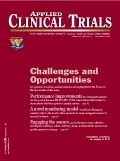FDA Warning Letters
Readers share their experience
FDA Warning Letters
Most clinical research professionals have copies of the International Conference on Harmonisation (ICH) guidelines and the
Code of Federal Regulations
sections pertaining to clinical research (21 CFR 50, 21 CFR 56, 21 CFR 312), but the guidelines and regulations can seem abstract. Reading and studying the regulations in Chapter 21 of the
Code of Federal Regulations
can be less than captivating.
Case histories gleaned from the findings of FDAs biomedical research monitoring, however, can reveal what FDA considers important in the conduct of clinical trials and the violations commonly cited by FDAs biomedical research inspectors.
GCP auditors and FDA compliance personnel often give engaging and educational presentations at meetings of regulatory affairs associations and local chapters of ACRP (Association of Clinical Research Professionals) and SoCRA (Society of Clinical Research Associates). Other excellent sources for learning more about regulatory affairs are workshops offered by other professional organizations, such as the Food and Drug Law Institute (www.fdli.org), the Drug Information Association (www.diahome.org), and the Regulatory Affairs Professionals Society (www.raps.org).
Meetings may be infrequent, however, and you may be unable to attend all the training workshops that interest you. Although its no substitute for more rigorous study, browsing the FDA (Food and Drug Administration) Warning Letters can give you a sense of the common inspection findings.
FDA issues Warning Letters to companies and individuals when an agency inspection reveals serious violations of specific regulations. Warning Letters describe the inspection and list the personnel involved from FDA and from the investigational site or company. The letter summarizes the findings, cites the specific regulations that were violated, and specifies the action to be taken. A typical warning letter ends with a request for a response within 15 days that outlines what steps will be taken to correct the violations.
Posted on Web site. Proprietary information and information revealing subject identity are deleted before the Warning Letters are posted on the FDA Web site (www.fda.gov/foi/warning.htm). The agency does not post responses from companies or individuals.
Search options. To read letters sent to clinical investigators, go to the FDA Web sites Warning Letter Search Form (http://63.75.126.221/scripts/wlcfm/searchwl.cfm), and type clinical investigator in the subject blank on the search form. If youre a monitor, the list of violations will probably look familiarbut one hopes it would be rare to have so many violations at a single site! One useful educational feature of the Warning Letters is that for each violation cited, FDA specifies the applicable regulation from the Code of Federal Regulations. If you dont have a copy of the CFR, you can read the regulations online at www.access.gpo.gov/nara/cfr/index.html. At the GPO Web site, choose Retrieve CFR sections by citation and enter the title, part, and section of the CFR that you want to review. For 21 CFR 312.60, for example, enter 21 as the title, 312 as the part, and 60 as the section. That search should retrieve the paragraph describing General responsibilities of investigators.
The list of Warning Letters will specify the issuing office, which might be a regional office or one of the centers, such as Center for Drug Evaluation and Research, Center for Biologics Evaluation and Research, or Center for Devices and Radiological Health. Use the search features to find Warning Letters on the particular topics that interest you. If you want to see Warning Letters concerning gene therapy studies, specify gene therapy as the subject. You could also specify Center for Biologics Evaluation and Research as the issuing office, since gene therapy is regulated by that center. If you want to retrieve warning letters sent to CROs or pharmaceutical/biotechnology companies, search using the phrase contract research organization or sponsor.
Just for fun, try a search using the word misbranded. You may be surprised to find warning letters describing Swiss cheese with 31.1% weight-to-weight milkfat. That cheese is misbranded as Swiss cheese because Swiss cheese must have a minimum of 43% milkfat, according to 21 CFR 133.195 (a). (Ill bet you never knew that.) Thats a reminder that FDA also regulates the food industry. Other search words that produce interesting results are false, misleading, and advertising. Spending an afternoon reading Warning Letters can give you a better appreciation of what the FDA does and the scope of Title 21 of the Code of Federal Regulations.
Barbara J. Rutledge, PhD, is president of Corvin Resources, Inc., P.O. Box 280, Apex, NC 27502-0280, (919) 367-8211, fax (919) 303-3728, e-mail: BarbaraR@corvinresources.com.

Improving Relationships and Diversifying the Site Selection Process
April 17th 2025In this episode of the Applied Clinical Trials Podcast, Liz Beatty, co-founder and chief strategy officer, Inato, discusses a number of topics around site engagement including community-based sites, the role of technology in improving site/sponsor relationships, how increased operational costs are impacting the industry, and more.
Behind the Buzz: Why Clinical Research Leaders Flock to SCOPE Summit
February 7th 2025In this episode, we meet with Micah Lieberman, Executive Conference Director for SCOPE Summit (Summit for Clinical Ops Executives) at Cambridge Innovation Institute. We will dive deep into the critical role of collaboration within the clinical research ecosystem. How do we bring together diverse stakeholders—sponsors, CROs, clinical trial tech innovators, suppliers, patients, sites, advocacy organizations, investors, and non-profits—to share best practices in trial design, program planning, innovation, and clinical operations? We’ll explore why it’s vital for thought leaders to step beyond their own organizations and learn from others, exchanging ideas that drive advancements in clinical research. Additionally, we’ll discuss the pivotal role of scientific conferences like SCOPE Summit in fostering these essential connections and collaborations, helping shape the future of clinical trials. Join us as we uncover how collective wisdom and cross-industry partnerships are transforming the landscape of clinical research.